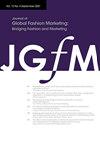男性和女性对肥胖时尚模特的含蓄否定
IF 5.5
Q2 BUSINESS
引用次数: 0
摘要
摘要本文的目的是调查女性对肥胖模型的相对积极反应是否是女性社会期望偏见的结果,而不是根深蒂固的态度。瑞典的60名大学生接受了内隐联想测试(IAT),以揭示参与者对肥胖模型的态度,而这些模型是参与者无法或不愿公开表达的。研究表明,尽管女性对肥胖模特的积极态度明显高于男性,但女性和男性对肥胖模特表现出相似的隐性消极态度。这项研究复制了之前显示的显性性别效应,但也通过引入内隐态度的测量,将性别偏好理论扩展到不同体型和体型的模特身上。最后,这篇论文提供了一个可能的解释,解释为什么时尚界在很大程度上不使用肥胖模特,尽管女性对她们表现出相对积极的态度。本文章由计算机程序翻译,如有差异,请以英文原文为准。
Men’s and women’s implicit negativity towards obese fashion models
ABSTRACT The purpose of this article is to investigate whether women’s relatively positive response to obese models is the result of social desirability bias on the part of women rather than deep seated attitudes. 60 university students in Sweden underwent an Implicit Associations Test (IAT) to reveal attitudes towards obese models that the participants were not able or willing to openly express. The study shows that even though women express significantly more positive attitudes towards obese models than men do, women and men display similar implicit negativity towards obese models. The study replicates a previously shown explicit gender effect, but also extends theory on gender preferences towards models of different sizes and body types by introducing measurements of implicit attitudes. Finally, the paper provides a possible explanation for why the fashion industry largely refrains from using obese models even though women express relatively positive attitudes towards them.
求助全文
通过发布文献求助,成功后即可免费获取论文全文。
去求助
来源期刊

Journal of Global Fashion Marketing
BUSINESS-
CiteScore
6.90
自引率
31.60%
发文量
34
期刊介绍:
The Journal of Global Fashion Marketing is a quarterly journal that publishes peer-reviewed conceptual and empirical papers and business cases of original works that significantly contribute to the overall advancement of marketing theory, research, and practice in fashion, design, and culture. JGFM endeavors to be a “global bridge” connecting marketing scholars and practitioners in fashion, design, and culture throughout the world. We publish high-quality scholarly articles on marketing written by contributors representing the leading academic authors. As we state on the cover of every issue, our positioning statement, our value added to the marketing scholar readership, is truly to “Bridge Fashion and Marketing” 1. Monitor and analyze global fashion marketing trends. 2. Generate and integrate new ideas and theories related to fashion, luxury, and culture marketing theory and practice. 3. Apply new research methods and techniques in fashion, luxury, and culture marketing. 4. Explore and disseminate cutting edge fashion marketing practices. JGFM welcomes manuscripts that provide fresh, innovative insight to any topic in the field of fashion, luxury, and culture marketing. Both conceptual and empirical works are valued, so long as the manuscript addresses substantive issues in marketing.
 求助内容:
求助内容: 应助结果提醒方式:
应助结果提醒方式:


